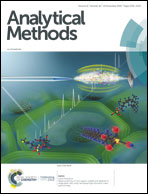Determination of phenolic compounds in alcoholic fermentation materials and spent grains by ultrasound-assisted alkali alcohol extraction coupled with HPLC
Abstract
The characteristics of five phenolic compounds in alcoholic fermentation materials and spent grains were evaluated by employing ultrasound-assisted alkali alcohol extraction coupled with high-performance liquid chromatography (HPLC). Due to the complexity of the matrix, the main factors influencing the extraction efficiency were optimized including the solid to liquid ratio, ultrasound temperature, time, pH, and alkali/alcohol ratio for ultrasonic-assisted extraction. Under the optimized extraction conditions, the method offered good linearity for (+)-catechin hydrate and syringic acid detection in the range of 0.08–10.01 mg L−1, for gallic acid in the range of 0.98–99.9 mg L−1, for p-coumaric acid in the range of 0.20–40.02 mg L−1, and for ferulic acid in the range of 2.01–400.11 mg L−1. The correlation coefficient (R2) of the standard curves was 0.9949–0.9993. The limit of detection (LOD) and limit of quantification (LOQ) were 0.072–18.340 μg L−1 and 0.235–60.798 μg L−1, respectively. The recovery rate of the five phenolic compounds was 82.32–85.22%. The content of the five phenolic compounds in the sample from the fermentation pit was also determined, indicating that the total content increased gradually from the upper to the bottom layer. Moreover, the comparison of the content of the five phenolic compounds in different fermentation pits showed good fermentation stability of the fermentation pits (the content of phenolic compounds is not much different).


 Please wait while we load your content...
Please wait while we load your content...